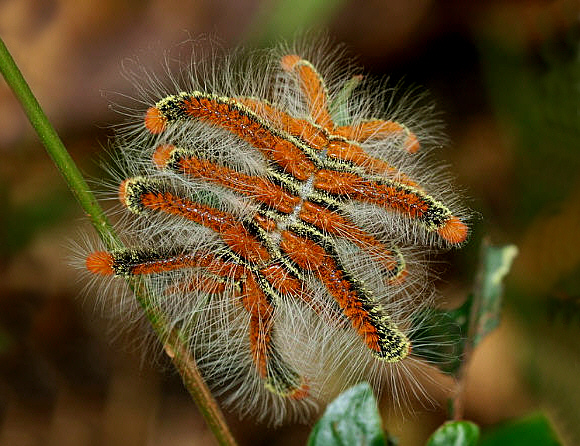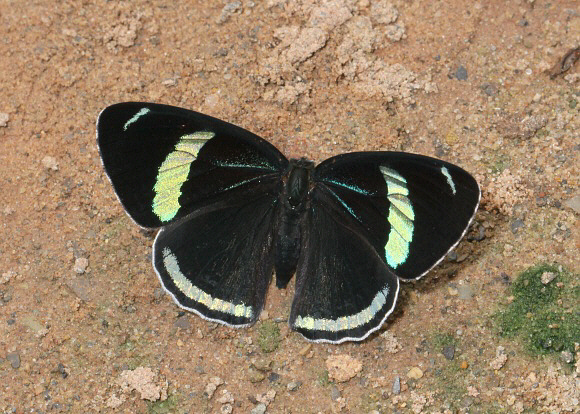Weirdest caterpillar on Earth ?
Caterpillars come in some strange shapes, but there can be few creatures more weird-looking than this bizarre Euphobetron moth larva ( Limacodidae ) from French Guiana. The photo does not depict a group of larvae – it is a single larva with enormous hairy limb-like lateral extensions!

Euphobetron aquapennis larva, French Guyana – Stéphane BRÛLÉ
Plants that trick butterflies !
Caterpillars of Cattle Heart butterflies ( Parides ) from South America feed on Aristolochia vines, but some vines can defend themselves by only “permitting” the butterflies to lay a small number of eggs. If extra eggs are laid, the leaf around the egg dies, and the dead tissue drops to the ground, carrying the egg with it ! A similar trick is played by Passiflora vines, which produce stipules at the base of leaf stems, that induce egg laying by some species of Heliconiine butterflies. A day or two later the stipules drop off, carrying the eggs with them.
Some other Passiflora vines produce tiny tubercles on the stipules that mimic Heliconiine eggs. Any butterfly visiting the plant sees the false eggs and is misled into thinking that the plant is already overladen with eggs, so is inhibited from adding more.
![]() Heliconius erato, Rio Madre de Dios, Peru – Adrian Hoskins
Heliconius erato, Rio Madre de Dios, Peru – Adrian Hoskins
Wings with ears !
Some butterflies can detect sound, using “ears” on the underside of their wings. These microscopic funnel-shaped ears are covered with a thin membrane that vibrates in response to high frequency sound. The ear is only present in certain butterfly families. Some scientists believe that all early butterflies were nocturnal, and that the ears evolved to enable them to detect and avoid predatory bats. Other butterfly families which do not possess ears are thought to have evolved daytime flight as an alternative anti-bat strategy.
Caterpillar cannibals !
Caterpillars of the Scarce Swallowtail Iphiclides podalirius are territorial. The silk trails which they lay as they walk along twigs have a slight odour. This enables each larva to recognise it’s own silk trail, and use it as a route map to find it’s way back to particularly succulent leaves. If two larvae meet, the larger one spins a silk web around the smaller one to kill it, or bites it to death.
Epiphile caterpillars in South America are equipped with long sharp poisonous “antlers” which they use to defend themselves against other insects. If disturbed they swish their heads violently, using the antlers to puncture the skin of attacking insects. The lepidopterist Muyshondt observed Epiphile caterpillars attacking each other, locking antlers until death.
Headless butterflies can still fly !
In June 2010, when in the Peruvian Andes I chanced upon a group of Diaethria butterflies settled on the ground. Most were busily imbibing mineralised moisture from the damp sand. One particular butterfly however was walking about, slowly fanning its wings. I crept closer in order to photograph it, and peering through the camera viewfinder I suddenly realised that the butterfly had no head! Despite having been decapitated ( following an attack by a bird or a wasp? ) it was perfectly able to walk, fan its wings and even to fly short distances!
The explanation is that insects have a nervous system in which certain functions are not centralised on the brain. Hence reproduction, locomotion and respiration are not dependent upon retaining a head. This not only explains why a headless Diaethria can walk and fly, it also explains how a male praying mantis can complete a sequence of mating processes with a female while she is eating his head ! This incidentally is normal behaviour for mantises – males passively submit to cannibalism, a practice that may have evolved because copulation duration and fertilisation success are almost doubled when the male is cannibalised.
 Diaethria clymena – walking and fanning its wings after decapitation, Shima, Peru – Adrian Hoskins
Diaethria clymena – walking and fanning its wings after decapitation, Shima, Peru – Adrian Hoskins
Intelligent butterflies !
The seemingly complex courtship rituals of many butterflies implies that they have some degree of intelligence, but careful analysis shows that the rituals are merely a series of instinctive responses to specific stimuli. A female for example might react in a certain way if approached by a male and showered with pheromones, but the male then also has to respond in a particular way which signals the female to initiate the next stage in the ritual, and so on.
However there is some evidence that certain butterflies do demonstrate intelligence and reasoning. Experiments have proven that Heliconius butterflies can learn home ranges within which they can memorise the locations of nectar and pollen sources, host plants and communal roosting sites. They are able to plan the most efficient route by which to visit all nectar / pollen sources in the vicinity by using simple calculations akin to what mathematicians call the “travelling salesman algorithm”.
